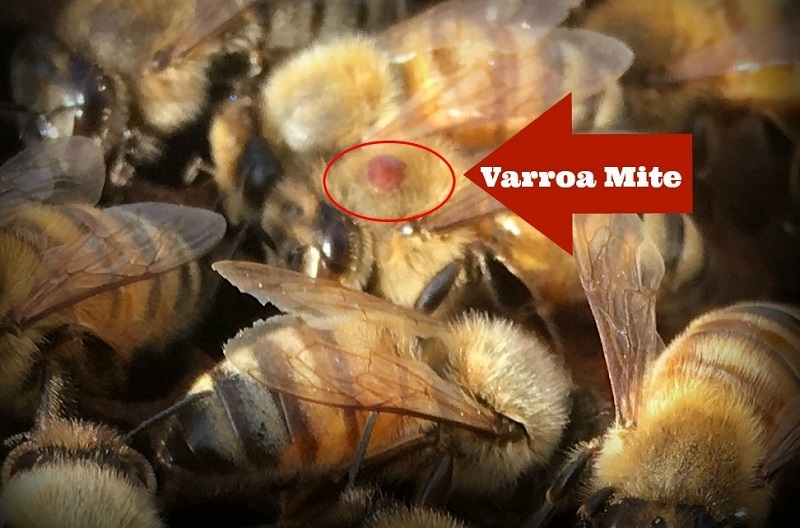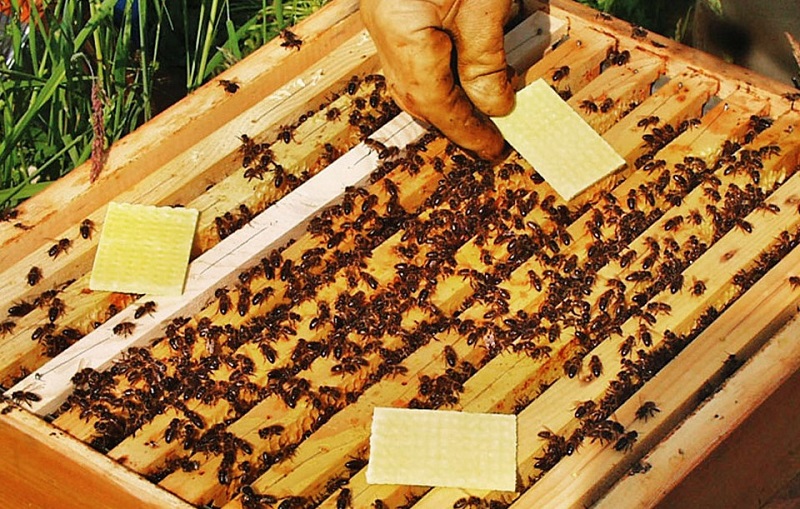Varroa mites are controlled using both commercial and homemade solutions. Homemade Varroa mite treatment alternatives are equally as effective as commercially created ones marketed in a variety of channels. This post will show you how to use homemade Varroa Mite treatment.
1. Varroa Mite Detection in Bee Colonies
Regular beehive examinations will reveal whether or not Varroa mites have taken up residence in your apiary. Mites will be found on bees. The mites are pinhead-sized, dark brown to reddish in color, and attach to the upper back of the thorax of bees. When the infection is severe and the mites have been in the hive for a long time, you may notice bees with malformed wings.
As a beekeeper, you risk incurring significant losses if you wait too long or are simply unaware of the Varroa mite infestation. The following are the primary losses caused by Varroa mites:
- When the infestation becomes too severe, bee colonies flee afflicted hives.
- Colonies are diminishing as a result of increased bee mortality and a large number of bees with damaged wings.
- Low honey and beehive product yields as a result of diminished colony capacity to forage and perform beehive management activities.

2. Homemade Varroa Mite Treatment Options
Homemade Varroa mite treatments are divided into four kinds. They are as follows:
- Natural Varroa mite control
- Powdered sugar treatments
- Chemical-free treatment options
- Mineral oil Varroa mite treatments
Each of these treatments has advantages and disadvantages. The benefit is that they are all effective and simple to implement. In comparison to commercially available options, the risk caused to bees by these homemade Varroa mite management treatments is also fairly minimal.
3. Natural Varroa Mite Control
Best beekeeping techniques are used in natural Varroa mite control approaches. They significantly lower the likelihood of Varroa mite infestations in your beehive. Here are the primary natural beekeeping activities you may incorporate into your own Varroa mite management program.
Using a drone foundation sheet to trap mites
Varroa mites prefer to nest on drones. So, keep a drone foundation sheet in the hive to trap Varroa mites. Wait for your honeybees to pull out and cap the cells. After that, freeze the frame for between 26 and 30 hours.
You may also make your own mite trap out of a deep frame with boards on each side. The boards keep bees out of the frame, but mites will get on it. The sticky paper at the bottom of the frame allows you to trap a lot of mites.
Take note of the following:
- All of the drone brood and mites will perish.
- This natural home remedy for Varroa mites can be used all year.
- You can reuse the foundation sheet without harming the honeybee colony.
Using screened bottom boards
Mites can fall to the ground when your hive has a screened bottom board. This is especially useful when bees are brushing Varroa mites off their backs or the backs of other bees. Mites brushed off bees remain in the hive with a firm bottom board and will almost certainly climb back onto adult bees.
If you live in a region where it is too chilly, you can utilize screened bottom boards in your hives during the warm seasons. In the colder months, especially in the winter, use sturdy bottom boards.

Mite-Resistant bee breeding
Some bee species are resistant to Varroa mites. These bee species that are resistant to Varroa mites exhibit enhanced brushing behavior, which results in mites being removed from the bees’ backs. In the bee colony, they also bite each other’s mites. In this approach, these bee varieties keep mite populations in the hive at a minimum.
Splitting Colonies
Mites rely totally on brood generation to complete their life cycle. Split your honey bee colonies every now and then. This reduces brood production in honey bees. As a result, the rate at which mites multiply in the hive is slowed. The bees from your split colony can be sold or used to create new beehives in your apiary.
Making use of smaller foundation cells
Mites have little area to grow alongside your hive brood in small cells. You can achieve this by using little foundation frames on purpose in your hive. Bees will then grow their cells to a size that is unappealing to mites. The mite population will decrease. This can be used in conjunction with another natural Varroa mite management approach to entirely eliminate mites from the beehive.
4. Powdered sugar varroa mite treatments
Powdered sugar is one of the most effective home remedies for Varroa mites. It works in two ways to control Varroa mites in bee colonies.
- For starters, the sugar works as a lubricant. Mites have a difficult time climbing onto and attaching themselves to bees. They slip off the bees and are easily removed from the hive.
- Powdered sugar also aids in Varroa mite management by stimulating grooming. They remove connected mites as part of the operation. The bees are bothered by the fact that they have sugar all over their body. They groom themselves and one other with the powdered sugar.
Take note of the following:
- Using powdered sugar frequently necessitates the preparation of your own powdered sugar.
- Pulverize the standard granulated white cane sugar you use at home to make your own powdered sugar. For each beehive box, you only need ½ cup of this sugar.
- The digestive tracts of honeybees are not fond of starch. Sugar in powder form, particularly confectioner’s sugar, includes starch.
>>> Read more: Top 10 Best Bee Smokers for Your Beehive
5. Treating varroa mites with essential oils
High-quality beehive products are harvested by beekeepers who use chemical-free treatment methods as part of their integrated pest control system. When compared to others, these products easily command greater market pricing.
Every beekeeper should be aware of two highly efficient chemical-free treatments for Varroa mites. The first is the use of essential oils in Varroa mite therapy at home. Mechanical mite management is another efficient way.
Using mint and thyme essential oils
These oils, in their pure form, unmixed with any other chemical, cause mites to fall off honey bees and not climb back. The essential oils in the hive disperse soon. They do not dissolve in beeswax or honey. Essential oils also have an effect on thoracic mites. Because essential oils outperform many conventional Varroa mite management approaches, they have grown in popularity among beekeepers.
How to use essential oils to treat hives:
- You need a few strips of absorbent material.
- Soak the material in your preferred essential oil and place the strips between your beehive frames.
- Use a sufficient amount of strips per beehive based on the number of boxes. The strips should be kept in the hive for at least three days, but no longer than a week.
To cope with freshly developed mites, repeat treatment after 3 weeks is ideal. Beekeepers that use essential oils to manage Varroa mites should use screened bottom boards in their hives. They allow mites to fall to the ground and make bee hive cleaning easier.

Using bee grooming instruments
Grooming tools for honeybees increase the effectiveness of natural honeybee grooming behavior. For optimal success, place these aids at the entrance of your hive. Other surfaces that bees can use to remove Varroa mites from their backs can also be tested by beekeepers.
Things to keep in mind:
- It is ideal to utilize a screened bottom board with homemade bee grooming tools to remove live, healthy mites from the bee’s back.
- Mites can be kept at bay in your beehive by using bee grooming tools. When utilized properly, they can do this for extended periods of time.
6. Mineral Oil Treatment
Fogging is a method of treating Varroa mites with mineral oil. It is preferable if the oil used is food grade. By using food grade oil, you can cure your hive while still stacking honey supers on top of it. Only the mites that have already hatched are killed by this DIY Varroa mite treatment. It has no effect on those who are still in the form of eggs or are contained in capped cells with brood. Mineral oil fogging can be done once or twice a month.
When you fog up your beehive with mineral oil, you should strongly consider utilizing a screened bottom board. Having a screened bottom board for a few days to a week after fogging allows mites to fall to the ground after being disengaged from bees.
Conclusion
If you are opposed to commercially available mite control solutions, you can utilize the following homemade alternatives to maintain your apiary free of Varroa mites and your bee colonies healthy all year.
>>> Read more: How to Treat Varroa Mite and Save Your Bees
